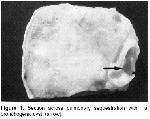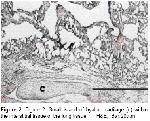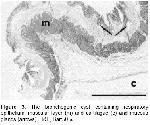There are 31 cases of bovine pulmonary sequestration in the literature. Sixteen of the cases (52.41%) are intra-abdominal sequestration, whereas 3 (9.68%) and 12 cases (38.71%) showed intrathoracal and subcutaneous locations, respectively. Two of the cases were fetus, one was 2-years-old and 5 were 2-5 weeks of age, and the remaining 23 calves were newborn. Subcutaneous sequetrations were located on neck, sacrum, shoulder (3 cases), thoracic inlet, head, left side of sternum, lumbar (2 cases), anus and unknown
4,5,6,7. Referring particularly to subcutaneous sequestrations, the overall good prognosis is determined by only few secondary congenital skletal defects due to pressure of the sequestrated lung and difficulty in delivery
5,7. Histological features of the sequestrated lung was similar to those previosly reported that bronchial hypoplasia and poorly developed alveoli were co-existent findings in almost all of bovine pulmonary sequestrations cases
7. Both pulmonary sequestration and bronchogenic cyst are considered as foregut malformation. The theory concerning how foregut malformation arise is that they are formed by extranumary lung bud that arises caudal to normal lung bud, and migrates caudally along with growing eosophagus
8. The cyst was apparently fulfilled to the histological criteria of the bronchogenic cyst such as pseudostrafied epithelium, hyaline cartilago and muscular layer
8,9. Although, small island of hyaline cartilage within the interstitium has not been reported in bovine sequestration cases, it was reported in pulmonary sequestration cases in man
10. The findings of present study showed that pulmonary sequestration and bronchonic cyst have common embryonic pathogenesis.





